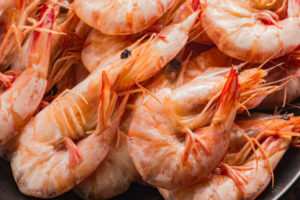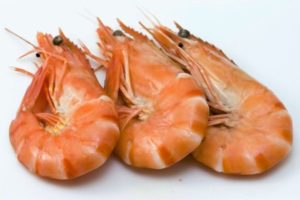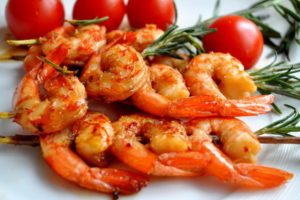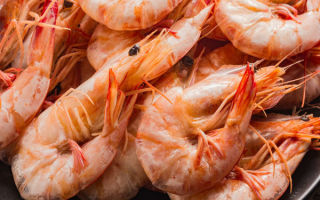Content
- 1 Shrimp chemical composition
- 2 Nutritional value and calorie content of shrimp
- 3 How much cholesterol is in shrimp
- 4 Useful properties of shrimp
- 5 Is it possible to eat shrimp for pregnant and lactating
- 6 Is it possible to give shrimp to children and at what age
- 7 Are pickled shrimp healthy?
- 8 Features of the use of shrimp for diseases
- 9 How many shrimp can you eat per day
- 10 How to cook shrimp
- 11 Shrimp harm and contraindications
- 12 Conclusion
The benefits and harms of shrimp are considered by most people during the preparation of the diet. The seafood delicacy has a lot of advantages, is a storehouse of useful substances, and its use is limited by only a few rules. These crustaceans are eaten in salted, pickled, fried, fresh, steamed, strengthening the cardiovascular and nervous systems, immunity due to the properties of the product, and improving overall health.

Shrimp chemical composition
Although initially the attitude towards shrimp meat was unfair, it was considered harmful, the study of the chemical composition and properties highlighted the value of the raw material. Crustaceans are recognized as suppliers of iodine to other marine life.
Shrimp also contains:
- essential amino acids;
- compounds of cobalt, manganese, molybdenum;
- trace elements magnesium, sodium, calcium, potassium;
- provitamin A, vitamins D, E, C, groups PP, B.
Shrimp meat is recognized as a storehouse of healthy protein, which not only maintains the tone of the muscles of the body, but is also necessary for the formation of collagen, which maintains elastic young skin. And the mineral balance, the presence of Omega-3 acids, and other properties of shrimp prevent the development of many diseases, strengthen bones, the circulatory system.

Nutritional value and calorie content of shrimp
Marine arthropods belong to dietary products, the calorie content of which often depends on the degree and type of processing.
|
Cooking method |
100 g |
|
Raw meat |
96 kcal |
|
Boiled |
95 kcal |
|
Breaded fried |
242 kcal |
|
Baked with sauce |
175 kcal |
|
For a couple |
99 kcal |
|
Lightly toasted |
116 kcal |
|
Pickled |
60-75 kcal |
The calorie content of popular king and tiger prawns is not much different: 86.9 and 90 kcal per 100 g, respectively.
The benefits of shrimp meat are complemented by the ability to eat deliciously without harming the body with hunger strikes or monotonous and nutrient-poor foods.
How much cholesterol is in shrimp

Shrimp contain a large amount of cholesterol, being the leader among seafood in this property. 100 g of crustacean meat contains 160-190 mg of cholesterol, but not more than 2.2 g of fat. These properties are an indicator that the benefits of using arthropods for many are greater than the harm. After all, they do not create conditions for the synthesis of cholesterol in the human body. In contrast, the beneficial unsaturated acids and the absence of saturated fats trigger the cleansing of the blood vessels.
Useful properties of shrimp

The benefits of shrimp for the human body have been studied not only theoretically, but also empirically. When properly prepared, seafood is delicious, which is a nice bonus to their valuable properties.
The use of marine crustaceans is recommended:
- during a diet;
- to strengthen muscles, bones;
- with immunodeficiency;
- in the process of recovering from a lingering ailment.
It is enough to consume 100 g of the product as part of a salad, so that the body receives the daily requirement of zinc, selenium and iodine necessary for normal functioning.
The benefits of shrimp for women
Women need to include healthy seafood in their diet. Due to their properties, crustaceans, in a few days of use, will make hair thicker, and nails strong, eliminate mood swings, and normalize hormones.
The mineral composition will help improve metabolism, get rid of fullness. In normal quantities, shrimp is recommended for pregnant women to maintain health, supplying the fetus with all the vitamins and microelements necessary for development. During and after menopause, seafood, due to its beneficial properties, will become the most accessible source of micronutrients.
Why shrimp are useful for men

The benefits of shrimp for men have been recognized since the days of Ancient Rome. They were used as a means of stimulating potency. Due to its low calorie content, food is quickly absorbed, does not burden the stomach, allowing amino acids, selenium and zinc to stimulate the biosynthesis of testosterone, positively affecting sexual function.
The product will be harmful if it has been frozen repeatedly, as evidenced by properties such as blackened heads, odor and unhealthy stains.
Shrimp for the elderly
The health benefits and harms of shrimp for older adults are controversial.
Product in small quantities:
- strengthens bones;
- protects against infections;
- normalizes cholesterol levels;
- stabilizes pressure.
That is, arthropod meat will help to cope with most of the problems typical for a certain age, if there are no contraindications from the attending physician caused by the properties and composition of seafood or individual intolerance.
Is it possible to eat shrimp for pregnant and lactating

Pregnant and lactating women should be especially careful about quality nutrition. Nutritionists insist on the benefits of seafood and its weekly use by this category of people. During both pregnancy and lactation, vitamins and polyunsaturated acids strengthen the mother's body, stimulating the development of the fetus and the correct growth of the baby.
Is it possible to give shrimp to children and at what age
Pediatricians' opinions on the benefits of shrimp in children's nutrition differ only regarding the age when the product can be included in the diet. Most of them insist on 3-4 years, and then the portions of the baby need to be increased gradually. For the first time, after consulting a pediatrician or doctor, a child should taste one shrimp, being supervised for at least a day after that.
The harm caused by crustaceans is evidenced by:
- sudden loose stools;
- labored breathing;
- the appearance of rashes;
- causeless rhinitis.
If there are no contraindications of the doctor and an allergic reaction, after reaching the age of 5, the child is allowed to give no more than 30-50 g of shrimp per day, which is equivalent to eating 100 g of fish or veal.
The teen's portion is increased to 70–80 g. The dishes prepared for children are flavored with sour cream sauce or lemon, but not with spices, because of which their properties are enhanced and can harm the child.
Are pickled shrimp healthy?

Pickled shrimp contain the least amount of calories without losing useful properties during cooking. They contain the same trace elements, protein and vitamins that are found in fresh raw materials. Eaten in this form, dietary arthropod meat serves as a natural natural protector of the body, strengthening it, improving disease resistance.
Features of the use of shrimp for diseases

The composition of beneficial crustaceans contains a unique antioxidant astaxanthin, which exceeds the effectiveness of similar substances found in fruits. It protects the body from premature age-related destruction, neutralizes stress, helps in the treatment of arthritis, gout, rheumatism and other common diseases. Moreover, the benefits of king prawns and not so large specimens are the same.
With diabetes mellitus
Shrimp is recommended for people suffering from diabetes. Iodine from arthropod meat will strengthen the body and help the internal organs to function properly. The dietary product is easily digested, cleanses the body of food waste, toxins. A daily portion of shrimp should not exceed 100 g, as the abundance of cholesterol in combination with minerals can neutralize the effects of medications taken, causing harm to health.
With pancreatitis

Treatment of the pancreas is inextricably linked to adherence to a strict diet, certain dietary restrictions. During an exacerbation of pancreatitis, it is better to refuse marine crustaceans. After the normalization of the indicators, the diet is replenished with useful shrimps as an ingredient in cutlets, soufflé, and cream soup.
With gastritis and stomach ulcers
The reasons that force you to refuse treats with stomach ulcers or gastritis due to the harm they cause are:
- exacerbation of the disease;
- increased acidity;
- allergic reaction;
- improper preparation.
Only boiled shrimp will be beneficial, served without excess salt, spices, lemon juice, which will irritate the walls of the stomach and increase the secretion of gastric juice. Served in a salad with boiled peas, a variety of vegetables, steamed or boiled shrimps, due to their properties, will only bring benefits.
How many shrimp can you eat per day
During the day, healthy adults are advised to eat no more than 100-120 g of shrimp, the norm for sick, elderly people and children is up to 100 g. Optimally, 50-75 g. It is advisable to diversify the diet, alternating healthy meat with other products.
How to cook shrimp

Shrimp are sold mainly frozen, so it is important to properly bring them to an edible state.
The beneficial properties of the product will be preserved if the following rules are observed:
- Thawing should take place gradually, about 10-12 hours.
- It is forbidden to use the microwave for a quick result.
- A frozen delicacy thrown into hot water loses its value.
- Shrimp spoil easily, which prohibits leaving them for a long time at room temperature.
It is best to resort to phased defrosting in the refrigerator, gradually lowering it from the upper shelf into the lower vegetable compartment, or place it in a colander in a saucepan of cold water, changing it every 20–30 minutes.
Harm of shrimp and contraindications

Like any healthy seafood, crustaceans can be harmful if consumed in excessive amounts. The danger is posed by cholesterol and heavy metals, which are increasing in sea waters every year. Many people suffer from seafood intolerance due to an excess of protein in them, which leads to problems in the digestive tract, allergic rashes. Shrimps grown on private farms, where hormones, growth stimulants, and antibiotics are used to achieve a quick result, are especially harmful.
Conclusion
The benefits and harms of shrimp do not depend on their size or where they are grown. Small individuals have no less nutrients than the largest of them - the royal ones. Moreover, the daily consumption of shrimp is limited to 100 g of pure meat. The product is useful for everyone with some limitations, thanks to it, the state of health improves significantly.

